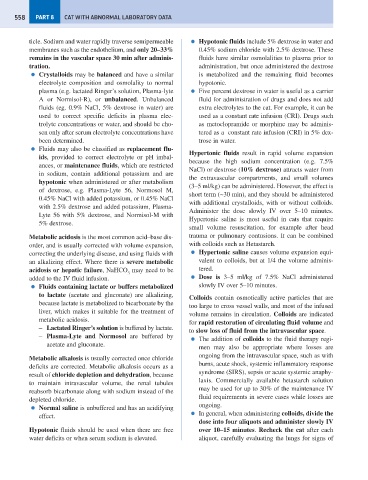Page 566 - Problem-Based Feline Medicine
P. 566
558 PART 8 CAT WITH ABNORMAL LABORATORY DATA
ticle. Sodium and water rapidly traverse semipermeable ● Hypotonic fluids include 5% dextrose in water and
membranes such as the endothelium, and only 20–33% 0.45% sodium chloride with 2.5% dextrose. These
remains in the vascular space 30 min after adminis- fluids have similar osmolalities to plasma prior to
tration. administration, but once administered the dextrose
● Crystalloids may be balanced and have a similar is metabolized and the remaining fluid becomes
electrolyte composition and osmolality to normal hypotonic.
plasma (e.g. lactated Ringer’s solution, Plasma-lyte ● Five percent dextrose in water is useful as a carrier
A or Normisol-R), or unbalanced. Unbalanced fluid for administration of drugs and does not add
fluids (eg. 0.9% NaCl, 5% dextrose in water) are extra electrolytes to the cat. For example, it can be
used to correct specific deficits in plasma elec- used as a constant rate infusion (CRI). Drugs such
trolyte concentrations or water, and should be cho- as metoclopramide or morphine may be adminis-
sen only after serum electrolyte concentrations have tered as a constant rate infusion (CRI) in 5% dex-
been determined. trose in water.
● Fluids may also be classified as replacement flu-
Hypertonic fluids result in rapid volume expansion
ids, provided to correct electrolyte or pH imbal-
because the high sodium concentration (e.g. 7.5%
ances, or maintenance fluids, which are restricted
NaCl) or dextrose (10% dextrose) attracts water from
in sodium, contain additional potassium and are
the extravascular compartments, and small volumes
hypotonic when administered or after metabolism
(3–5 ml/kg) can be administered. However, the effect is
of dextrose, e.g. Plasma-Lyte 56, Normosol M,
short term (~30 min), and they should be administered
0.45% NaCl with added potassium, or 0.45% NaCl
with additional crystalloids, with or without colloids.
with 2.5% dextrose and added potassium, Plasma-
Administer the dose slowly IV over 5–10 minutes.
Lyte 56 with 5% dextrose, and Normisol-M with
Hypertonic saline is most useful in cats that require
5% dextrose.
small volume resuscitation, for example after head
Metabolic acidosis is the most common acid–base dis- trauma or pulmonary contusions. It can be combined
order, and is usually corrected with volume expansion, with colloids such as Hetastarch.
correcting the underlying disease, and using fluids with ● Hypertonic saline causes volume expansion equi-
an alkalizing effect. Where there is severe metabolic valent to colloids, but at 1/4 the volume adminis-
acidosis or hepatic failure, NaHCO may need to be tered.
3
added to the IV fluid infusion. ● Dose is 3–5 ml/kg of 7.5% NaCl administered
● Fluids containing lactate or buffers metabolized slowly IV over 5–10 minutes.
to lactate (acetate and gluconate) are alkalizing,
Colloids contain osmotically active particles that are
because lactate is metabolized to bicarbonate by the
too large to cross vessel walls, and most of the infused
liver, which makes it suitable for the treatment of
volume remains in circulation. Colloids are indicated
metabolic acidosis.
for rapid restoration of circulating fluid volume and
– Lactated Ringer’s solution is buffered by lactate.
to slow loss of fluid from the intravascular space.
– Plasma-Lyte and Normosol are buffered by
● The addition of colloids to the fluid therapy regi-
acetate and gluconate.
men may also be appropriate where losses are
ongoing from the intravascular space, such as with
Metabolic alkalosis is usually corrected once chloride
burns, acute shock, systemic inflammatory response
deficits are corrected. Metabolic alkalosis occurs as a
syndrome (SIRS), sepsis or acute systemic anaphy-
result of chloride depletion and dehydration, because
laxis. Commercially available hetastarch solution
to maintain intravascular volume, the renal tubules
may be used for up to 30% of the maintenance IV
reabsorb bicarbonate along with sodium instead of the
fluid requirements in severe cases while losses are
depleted chloride.
ongoing.
● Normal saline is unbuffered and has an acidifying
● In general, when administering colloids, divide the
effect.
dose into four aliquots and administer slowly IV
Hypotonic fluids should be used when there are free over 10–15 minutes. Recheck the cat after each
water deficits or when serum sodium is elevated. aliquot, carefully evaluating the lungs for signs of

